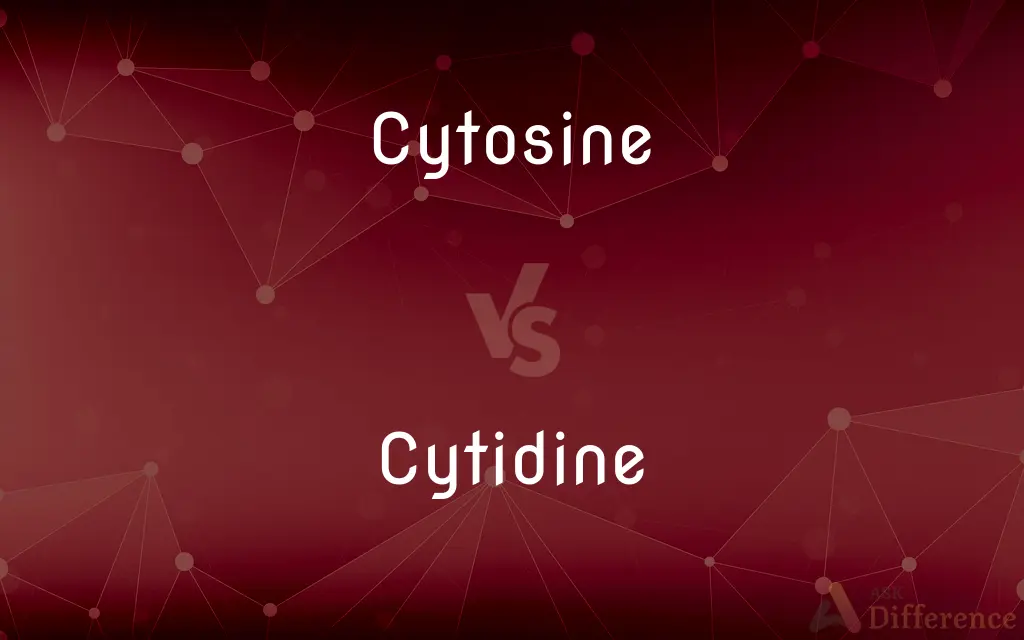Cytosine vs. Cytidine — What's the Difference?
By Tayyaba Rehman & Maham Liaqat — Updated on March 28, 2024
Cytosine is one of the four main bases found in DNA and RNA, essential for storing genetic information, while cytidine is a nucleoside combining cytosine and ribose, playing key roles in RNA.

Difference Between Cytosine and Cytidine
Table of Contents
ADVERTISEMENT
Key Differences
Cytosine is a nitrogenous base that pairs with guanine in DNA and RNA through hydrogen bonding, which is crucial for the structure of the genetic code. On the other hand, cytidine is a compound that consists of cytosine attached to a ribose sugar, forming a nucleoside that is incorporated into RNA strands.
Cytosine's role is primarily in the formation of genetic material, where it acts as one of the four bases coding for genetic information. Whereas cytidine functions as a building block of RNA, necessary for protein synthesis and various cellular activities.
In the context of mutations, cytosine can undergo changes that lead to genetic mutations, affecting the organism's traits or health. Whereas alterations in cytidine levels can influence RNA stability and protein synthesis, impacting cellular function and regulation.
Cytosine is also involved in DNA methylation, a process critical for gene expression and regulation. On the other hand, cytidine can be modified to form different molecules like cytidine triphosphate (CTP), playing a role in energy transfer and lipid synthesis.
The study of cytosine is essential in understanding genetic diseases and developing gene therapies. Conversely, research on cytidine and its derivatives is vital for advancing RNA-based treatments and understanding metabolic diseases.
ADVERTISEMENT
Comparison Chart
Definition
A nitrogenous base found in DNA and RNA.
A nucleoside that includes cytosine and ribose.
Role
Codes for genetic information by pairing with guanine.
Serves as a building block of RNA.
Chemical Structure
Composed of a pyrimidine ring.
Composed of a pyrimidine ring and a ribose sugar.
Function
Involved in storing genetic information.
Involved in protein synthesis and cellular activities.
Importance in Mutations
Changes can lead to genetic mutations.
Alterations can affect RNA stability and function.
Compare with Definitions
Cytosine
Cytosine participates in the genetic code of organisms.
Mutations in cytosine bases can lead to genetic disorders.
Cytidine
Plays a role in cellular signaling and metabolism.
Cytidine diphosphate (CDP) is involved in lipid synthesis.
Cytosine
Cytosine can be modified through chemical reactions.
Deamination of cytosine produces uracil, affecting RNA's structure.
Cytidine
A nucleoside composed of cytosine and a ribose sugar.
Cytidine is a key component of RNA, necessary for protein synthesis.
Cytosine
A pyrimidine nucleobase in DNA and RNA that pairs with guanine.
Cytosine undergoes methylation to regulate gene expression.
Cytidine
Can be converted into cytidine triphosphate (CTP) for energy transfer.
CTP is essential for the synthesis of biological membranes.
Cytosine
Acts in DNA methylation and genetic regulation.
The cytosine methylation pattern is crucial for embryonic development.
Cytidine
Affects brain health and cognitive functions.
Cytidine supplements are studied for their potential in improving memory.
Cytosine
Involved in the storage and transmission of genetic information.
Cytosine's sequence in DNA determines an organism's traits.
Cytidine
Involved in the regulation of gene expression.
Modifications of cytidine in RNA can influence gene activity.
Cytosine
A pyrimidine (C4H5N3O) which is one of the four major basic components of DNA and RNA in most organisms, forming glyosides with ribose and deoxyribose. It is the basic component of cytidine, deoxycytidine, cytosine, cytidine monophosphate, and derivatives of those compounds.
Cytidine
Cytidine (symbol C or Cyd) is a nucleoside molecule that is formed when cytosine is attached to a ribose ring (also known as a ribofuranose) via a β-N1-glycosidic bond. Cytidine is a component of RNA. It is a white water-soluble solid.
Cytosine
Cytosine (; C) is one of the four main bases found in DNA and RNA, along with adenine, guanine, and thymine (uracil in RNA). It is a pyrimidine derivative, with a heterocyclic aromatic ring and two substituents attached (an amine group at position 4 and a keto group at position 2).
Cytidine
A nucleoside, C9H13N3O5, composed of cytosine and ribose.
Cytosine
A pyrimidine base, C4H5N3O, that is the constituent of DNA and RNA involved in base-pairing with guanine.
Cytidine
A nucleoside consisting of cytosine linked to ribose, occurring in human RNA
Cytosine
(biochemistry) A heterocyclic base, 4-aminopyrimidin-2(1H)-one, which pairs with guanine in DNA and RNA (by means of three hydrogen bonds).
Cytidine
A nucleoside component of DNA; composed of cytosine and deoxyribose
Cytosine
A base found in DNA and RNA and derived from pyrimidine; pairs with guanine
Common Curiosities
Can changes in cytosine lead to genetic disorders?
Yes, mutations in cytosine bases can result in genetic mutations, potentially leading to disorders.
How do cytosine and cytidine differ in structure?
Cytosine is just a nitrogenous base, while cytidine is a nucleoside, which includes both cytosine and a ribose sugar.
What roles do cytosine and cytidine play in genetics?
Cytosine is involved in storing genetic information, whereas cytidine plays a role in RNA synthesis and function.
What are the implications of cytosine deamination?
Deamination of cytosine to uracil can lead to RNA structural changes and potential genetic mutations.
How do cytosine and cytidine impact brain health?
While cytosine's role is more structural in DNA/RNA, cytidine and its derivatives have been studied for their potential effects on cognitive functions and memory.
What is cytosine?
Cytosine is a pyrimidine nucleobase found in DNA and RNA, essential for coding genetic information.
What is DNA methylation, and how is cytosine involved?
DNA methylation is a process of modifying cytosine to regulate gene expression, crucial for development and health.
What is cytidine?
Cytidine is a nucleoside that consists of the base cytosine attached to a ribose sugar, important in RNA structure.
How is cytidine involved in protein synthesis?
Cytidine is a component of RNA, which translates genetic information into proteins.
What is the importance of cytidine in cellular metabolism?
Cytidine derivatives, such as CTP, are involved in energy transfer and lipid synthesis, essential for cellular function.
How do cytosine and cytidine contribute to gene regulation?
Cytosine's methylation patterns influence gene expression, while modifications of cytidine can affect RNA's role in gene regulation.
How does cytidine participate in the synthesis of biological membranes?
Cytidine triphosphate (CTP) is involved in the synthesis of phospholipids, the main components of biological membranes.
What is the difference between cytosine and uracil?
Cytosine is found in both DNA and RNA, pairing with guanine, while uracil replaces cytosine in RNA, pairing with adenine.
Can cytidine levels affect health?
Yes, abnormal levels of cytidine and its derivatives can impact cellular metabolism and brain function.
Why is the study of cytosine important in genetics?
Understanding cytosine and its functions is crucial for genetic research, including gene therapy and studying hereditary diseases.
Share Your Discovery

Previous Comparison
Intramuscular vs. Intermuscular
Next Comparison
Submarine vs. UnderwaterAuthor Spotlight
Written by
Tayyaba RehmanTayyaba Rehman is a distinguished writer, currently serving as a primary contributor to askdifference.com. As a researcher in semantics and etymology, Tayyaba's passion for the complexity of languages and their distinctions has found a perfect home on the platform. Tayyaba delves into the intricacies of language, distinguishing between commonly confused words and phrases, thereby providing clarity for readers worldwide.
Co-written by
Maham Liaqat













































